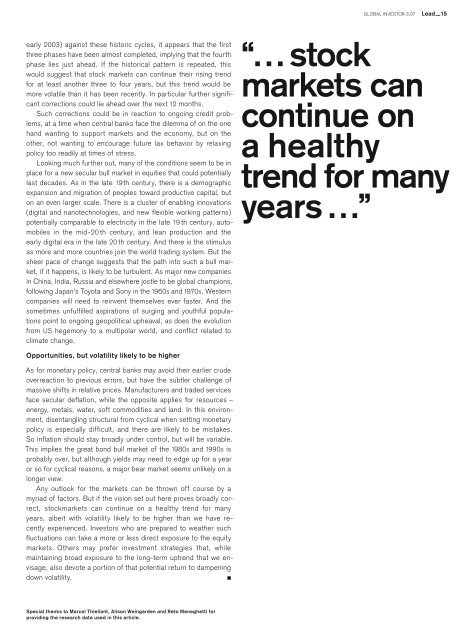Investment strategies for volatile markets
Global Investor, 03/2007 Credit Suisse
Global Investor, 03/2007
Credit Suisse
You also want an ePaper? Increase the reach of your titles
YUMPU automatically turns print PDFs into web optimized ePapers that Google loves.
GLOBAL INVESTOR 3.07 Lead — 15<br />
early 2003) against these historic cycles, it appears that the first<br />
three phases have been almost completed, implying that the fourth<br />
phase lies just ahead. If the historical pattern is repeated, this<br />
would suggest that stock <strong>markets</strong> can continue their rising trend<br />
<strong>for</strong> at least another three to four years, but this trend would be<br />
more <strong>volatile</strong> than it has been recently. In particular further significant<br />
corrections could lie ahead over the next 12 months.<br />
Such corrections could be in reaction to ongoing credit problems,<br />
at a time when central banks face the dilemma of on the one<br />
hand wanting to support <strong>markets</strong> and the economy, but on the<br />
other, not wanting to encourage future lax behavior by relaxing<br />
policy too readily at times of stress.<br />
Looking much further out, many of the conditions seem to be in<br />
place <strong>for</strong> a new secular bull market in equities that could potentially<br />
last decades. As in the late 19th century, there is a demographic<br />
expansion and migration of peoples toward productive capital, but<br />
on an even larger scale. There is a cluster of enabling innovations<br />
(digital and nanotechnologies, and new flexible working patterns)<br />
potentially comparable to electricity in the late 19 th century, automobiles<br />
in the mid-20 th century, and lean production and the<br />
early digital era in the late 20 th century. And there is the stimulus<br />
as more and more countries join the world trading system. But the<br />
sheer pace of change suggests that the path into such a bull market,<br />
if it happens, is likely to be turbulent. As major new companies<br />
in China, India, Russia and elsewhere jostle to be global champions,<br />
following Japan’s Toyota and Sony in the 1960s and 1970s, Western<br />
companies will need to reinvent themselves ever faster. And the<br />
sometimes unfulfilled aspirations of surging and youthful populations<br />
point to ongoing geopolitical upheaval, as does the evolution<br />
from hegemony to a multipolar world, and conflict related to<br />
climate change.<br />
“… stock<br />
<strong>markets</strong> can<br />
continue on<br />
a healthy<br />
trend <strong>for</strong> many<br />
years …”<br />
Opportunities, but volatility likely to be higher<br />
As <strong>for</strong> monetary policy, central banks may avoid their earlier crude<br />
overreaction to previous errors, but have the subtler challenge of<br />
massive shifts in relative prices. Manufacturers and traded services<br />
face secular deflation, while the opposite applies <strong>for</strong> resources –<br />
energy, metals, water, soft commodities and land. In this environment,<br />
disentangling structural from cyclical when setting monetary<br />
policy is especially difficult, and there are likely to be mistakes.<br />
So inflation should stay broadly under control, but will be variable.<br />
This implies the great bond bull market of the 1980s and 1990s is<br />
probably over, but although yields may need to edge up <strong>for</strong> a year<br />
or so <strong>for</strong> cyclical reasons, a major bear market seems unlikely on a<br />
longer view.<br />
Any outlook <strong>for</strong> the <strong>markets</strong> can be thrown off course by a<br />
myriad of factors. But if the vision set out here proves broadly correct,<br />
stock<strong>markets</strong> can continue on a healthy trend <strong>for</strong> many<br />
years, albeit with volatility likely to be higher than we have recently<br />
experienced. Investors who are prepared to weather such<br />
fluctuations can take a more or less direct exposure to the equity<br />
<strong>markets</strong>. Others may prefer investment <strong>strategies</strong> that, while<br />
maintaining broad exposure to the long-term uptrend that we envisage,<br />
also devote a portion of that potential return to dampening<br />
down volatility.<br />
<br />
Special thanks to Marcel Thieliant, Alison Weingarden and Reto Meneghetti <strong>for</strong><br />
providing the research data used in this article.

















